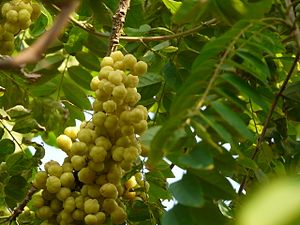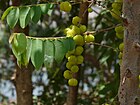Note: This is a project under development. The articles on this wiki are just being initiated and broadly incomplete. You can Help creating new pages.
Difference between revisions of "Phyllanthus distichus"
| Line 1: | Line 1: | ||
| − | + | [[File:Rayamvala (Marathi- रायआंवळा) (3438727924).jpg |thumb|right|'''Phyllanthus distichus''']] | |
| + | '''Phyllanthus distichus''' is a species of flowering plant in the family Phyllanthaceae, native to the Hawaiian Islands. | ||
==Uses== | ==Uses== | ||
| − | {{Uses|}}, {{Uses| | + | {{Uses|Diabetes}}, {{Uses|Fever}}. |
==Parts Used== | ==Parts Used== | ||
| − | {{Parts Used|}}, {{Parts Used| | + | {{Parts Used|Fruits}}, {{Parts Used|Leaves}}. |
==Chemical Composition== | ==Chemical Composition== | ||
| − | + | These fruits are reputed to contain high amounts of ascorbic acid (vitamin C), and have bitter taste that may derive from a high density of ellagitannins, such as emblicanin A (37%), emblicanin B (33%), punigluconin (12%), and pedunculagin (14%). Amla also contains punicafolin and phyllanemblinin A, phyllanemblin other polyphenols, such as flavonoids, kaempferol, ellagic acid, and gallic acid. | |
| + | |||
==Common names== | ==Common names== | ||
| − | {{Common names | + | {{Common names|kn=Betta nelli, Amalaka|ml= Nelli, Nellikka|sa=Dhatri, amalaka|ta=Nelli|te=Usiri, Usirikaya|hi=आँवला Aonla|en=Amla, Indian gooseberry}} |
==Properties== | ==Properties== | ||
Reference: Dravya - Substance, Rasa - Taste, Guna - Qualities, Veerya - Potency, Vipaka - Post-digesion effect, Karma - Pharmacological activity, Prabhava - Therepeutics. | Reference: Dravya - Substance, Rasa - Taste, Guna - Qualities, Veerya - Potency, Vipaka - Post-digesion effect, Karma - Pharmacological activity, Prabhava - Therepeutics. | ||
===Dravya=== | ===Dravya=== | ||
| + | |||
===Rasa=== | ===Rasa=== | ||
| − | |||
===Guna=== | ===Guna=== | ||
===Veerya=== | ===Veerya=== | ||
| − | + | Cold(Sheeta) | |
===Vipaka=== | ===Vipaka=== | ||
| Line 29: | Line 31: | ||
==Habit== | ==Habit== | ||
| − | {{Habit|}} | + | {{Habit|Tree}} |
==Identification== | ==Identification== | ||
===Leaf=== | ===Leaf=== | ||
| − | {{Leaf|||}}<ref name="Leaf"/> | + | {{Leaf|Simple|round in outline|10–20 cm (3.9–7.9 in) long subsessile and closely set along branchlets, light green, resembling pinnate leaves.}}<ref name="Leaf"/> |
===Flower=== | ===Flower=== | ||
| − | {{Flower||||}} | + | {{Flower|Bisexual||Greenish-yellow||}} |
===Fruit=== | ===Fruit=== | ||
| − | {{Fruit|||| | + | {{Fruit|Simple Fruit|Spherical|Smooth and hard on appearance, with six vertical stripes or furrows.|Light greenish-yellow|}} |
===Other features=== | ===Other features=== | ||
| Line 46: | Line 48: | ||
==Where to get the saplings== | ==Where to get the saplings== | ||
| − | |||
==Mode of Propagation== | ==Mode of Propagation== | ||
| − | {{Propagation|}} | + | {{Propagation|Seeds}}. |
==How to plant/cultivate== | ==How to plant/cultivate== | ||
| + | A plant mainly of the hot, tropical lowlands, succeeding in both humid and semi-arid areas. It can also be found at elevations up to 2,300 metres in southern China. It grows best in areas where annual daytime temperatures are within the range 20 - 29°c, but can tolerate 14 - 35°c. It prefers a mean annual rainfall in the range 1,500 - 2,500mm, but tolerates 700 - 4,200mm. | ||
<ref name="How to plant/cultivate"/> | <ref name="How to plant/cultivate"/> | ||
==Commonly seen growing in areas== | ==Commonly seen growing in areas== | ||
| − | {{Commonly seen| | + | {{Commonly seen|Lowland forest}}. |
==Photo Gallery== | ==Photo Gallery== | ||
<gallery class="left" caption="" widths="140px" heights="140px"> | <gallery class="left" caption="" widths="140px" heights="140px"> | ||
| − | + | File:Starr-061108-9707-Phyllanthus distichus-habit from Black Gorge Iao-Hoolawa Farms-Maui (24241712883).jpg | |
| + | File:Phyllanthus acidus (2464194687).jpg | ||
</gallery> | </gallery> | ||
==References== | ==References== | ||
| + | |||
<references> | <references> | ||
| − | |||
| − | <ref name="Leaf">[ | + | <ref name="Leaf">[https://en.wikipedia.org/wiki/Phyllanthus_emblica Morphology]</ref> |
| − | <ref name="How to plant/cultivate">[ | + | <ref name="How to plant/cultivate">[http://tropical.theferns.info/viewtropical.php?id=Phyllanthus+emblica Cultivation Details]</ref> |
| − | |||
</references> | </references> | ||
==External Links== | ==External Links== | ||
| − | * [ ] | + | * [http://www.theplantlist.org/tpl1.1/record/kew-153790 Phyllanthus distichus] |
| − | + | ||
| − | + | ||
[[Category:Herbs]] | [[Category:Herbs]] | ||
| − | [[Category: | + | [[Category: Phyllanthaceae]] |
Revision as of 15:40, 15 June 2020
Phyllanthus distichus is a species of flowering plant in the family Phyllanthaceae, native to the Hawaiian Islands.
Contents
- 1 Uses
- 2 Parts Used
- 3 Chemical Composition
- 4 Common names
- 5 Properties
- 6 Habit
- 7 Identification
- 8 List of Ayurvedic medicine in which the herb is used
- 9 Where to get the saplings
- 10 Mode of Propagation
- 11 How to plant/cultivate
- 12 Commonly seen growing in areas
- 13 Photo Gallery
- 14 References
- 15 External Links
Uses
Parts Used
Chemical Composition
These fruits are reputed to contain high amounts of ascorbic acid (vitamin C), and have bitter taste that may derive from a high density of ellagitannins, such as emblicanin A (37%), emblicanin B (33%), punigluconin (12%), and pedunculagin (14%). Amla also contains punicafolin and phyllanemblinin A, phyllanemblin other polyphenols, such as flavonoids, kaempferol, ellagic acid, and gallic acid.
Common names
| Language | Common name |
|---|---|
| Kannada | Betta nelli, Amalaka |
| Hindi | आँवला Aonla |
| Malayalam | Nelli, Nellikka |
| Tamil | Nelli |
| Telugu | Usiri, Usirikaya |
| Marathi | NA |
| Gujarathi | NA |
| Punjabi | NA |
| Kashmiri | NA |
| Sanskrit | Dhatri, amalaka |
| English | Amla, Indian gooseberry |
Properties
Reference: Dravya - Substance, Rasa - Taste, Guna - Qualities, Veerya - Potency, Vipaka - Post-digesion effect, Karma - Pharmacological activity, Prabhava - Therepeutics.
Dravya
Rasa
Guna
Veerya
Cold(Sheeta)
Vipaka
Karma
Prabhava
Habit
Identification
Leaf
| Kind | Shape | Feature |
|---|---|---|
| Simple | round in outline | 10–20 cm (3.9–7.9 in) long subsessile and closely set along branchlets, light green, resembling pinnate leaves. |
Flower
| Type | Size | Color and composition | Stamen | More information |
|---|---|---|---|---|
| Bisexual | Greenish-yellow |
Fruit
| Type | Size | Mass | Appearance | Seeds | More information |
|---|---|---|---|---|---|
| Simple Fruit | Spherical | Smooth and hard on appearance, with six vertical stripes or furrows. | Light greenish-yellow | {{{6}}} |
Other features
List of Ayurvedic medicine in which the herb is used
Where to get the saplings
Mode of Propagation
How to plant/cultivate
A plant mainly of the hot, tropical lowlands, succeeding in both humid and semi-arid areas. It can also be found at elevations up to 2,300 metres in southern China. It grows best in areas where annual daytime temperatures are within the range 20 - 29°c, but can tolerate 14 - 35°c. It prefers a mean annual rainfall in the range 1,500 - 2,500mm, but tolerates 700 - 4,200mm. [2]
Commonly seen growing in areas
Photo Gallery
References
External Links
- Ayurvedic Herbs known to be helpful to treat Diabetes
- Ayurvedic Herbs known to be helpful to treat Fever
- Herbs with Fruits used in medicine
- Herbs with Leaves used in medicine
- Herbs with common name in Kannada
- Herbs with common name in Hindi
- Herbs with common name in Malayalam
- Herbs with common name in Tamil
- Herbs with common name in Telugu
- Herbs with common name in Sanskrit
- Herbs with common name in English
- Habit - Tree
- Index of Plants which can be propagated by Seeds
- Herbs that are commonly seen in the region of Lowland forest
- Herbs
- Phyllanthaceae


